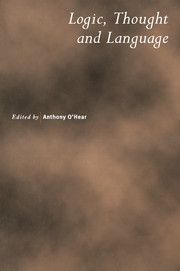Book contents
- Frontmatter
- Contents
- Preface
- Notes on Contributors
- What logic should we think with?
- Mental Representation and Mental Presentation
- Self-knowledge, Normativity, and Construction
- The Normativity of Meaning
- Two Theories of Names
- Relativism and Classical Logic
- Principles for Possibilia
- What are these Familiar Words Doing Here?
- Particular Thoughts & Singular Thought
- Conditional Belief and the Ramsey Test
- Necessary Existents
- Ambiguity and Belief
- Basic Logical Knowledge
- Frege's Target
- Index
Ambiguity and Belief
Published online by Cambridge University Press: 05 October 2010
- Frontmatter
- Contents
- Preface
- Notes on Contributors
- What logic should we think with?
- Mental Representation and Mental Presentation
- Self-knowledge, Normativity, and Construction
- The Normativity of Meaning
- Two Theories of Names
- Relativism and Classical Logic
- Principles for Possibilia
- What are these Familiar Words Doing Here?
- Particular Thoughts & Singular Thought
- Conditional Belief and the Ramsey Test
- Necessary Existents
- Ambiguity and Belief
- Basic Logical Knowledge
- Frege's Target
- Index
Summary
1. This paper is concerned with the notion of ambiguity—or what I shall refer to more generally as homonymy—and its bearing upon various familiar puzzles about intensional contexts. It would hardly of course be a novel claim that the unravelling of such puzzles may well involve recourse to something like ambiguity. After all, Frege, who bequeathed to us one of the most enduring of the puzzles, proposed as part of his solution an analysis of intensional contexts according to which all expressions change their sense when embedded in such contexts. (Indeed they change their sense with each embedding.) And many contemporary philosophers who have discussed the puzzles, while not perhaps endorsing Frege's own somewhat extreme view, nevertheless take ambiguities in the contained sentences to be the key to the puzzles. In this paper, however, I wish to follow those who take the crucial source of homonymy, at least in the most difficult of the puzzles, to lie primarily not in the embedded sentences, but rather in the intensional verbs that embed them. I begin with a brief examination of certain aspects of ambiguity and homonymy.
2. An expression is ambiguous if it has more than one meaning. So the ways of specifying ambiguities will be at least as various as the ways of specifying the meanings themselves. For example, just as certain expressions, such as ‘vixen’ (female fox) or ‘Ø’ (the empty set), admit of analysis or definition, so also expressions such as ‘port’, which admit of more than one analysis or definition, are ambiguous.
- Type
- Chapter
- Information
- Logic, Thought and Language , pp. 253 - 278Publisher: Cambridge University PressPrint publication year: 2002



